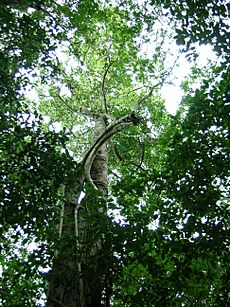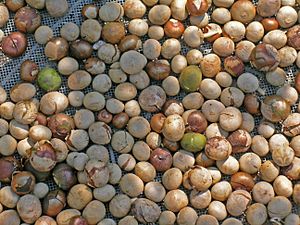Breadnut facts for kids
Quick facts for kids Breadnut |
|
|---|---|
 |
|
| Scientific classification | |
| Genus: |
Brosimum
|
| Species: |
alicastrum
|
| Synonyms | |
|
Alicastrum brownei Kuntze |
|
| Nutritional value per 100 g (3.5 oz) | |
|---|---|
| Energy | 908 kJ (217 kcal) |
|
46.28 g
|
|
|
0.99 g
|
|
| Saturated | 0.267 g |
| Monounsaturated | 0.126 g |
| Polyunsaturated | 0.527 g |
|
Protein
|
5.97 g
|
| Tryptophan | 0.162 g |
| Threonine | 0.232 g |
| Isoleucine | 0.338 g |
| Leucine | 0.647 g |
| Lysine | 0.260 g |
| Methionine | 0.035 g |
| Cystine | 0.093 g |
| Phenylalanine | 0.282 g |
| Tyrosine | 0.439 g |
| Valine | 0.578 g |
| Arginine | 0.549 g |
| Histidine | 0.091 g |
| Alanine | 0.271 g |
| Aspartic acid | 0.659 g |
| Glutamic acid | 0.835 g |
| Glycine | 0.375 g |
| Proline | 0.297 g |
| Serine | 0.400 g |
| Vitamins | Quantity
%DV†
|
| Vitamin A equiv. |
2%
12 μg |
| Thiamine (B1) |
5%
0.055 mg |
| Riboflavin (B2) |
5%
0.055 mg |
| Niacin (B3) |
6%
0.880 mg |
| Pantothenic acid (B5) |
22%
1.103 mg |
| Vitamin B6 |
31%
0.403 mg |
| Folate (B9) |
17%
66 μg |
| Vitamin B12 |
0%
0.00 μg |
| Vitamin C |
33%
27.4 mg |
| Minerals | Quantity
%DV†
|
| Calcium |
10%
98 mg |
| Copper |
72%
1.444 mg |
| Iron |
16%
2.09 mg |
| Magnesium |
19%
68 mg |
| Manganese |
8%
0.178 mg |
| Phosphorus |
10%
67 mg |
| Potassium |
39%
1183 mg |
| Sodium |
2%
31 mg |
| Zinc |
12%
1.13 mg |
| Other constituents | Quantity |
| Water | 45.00 g |
|
Link to USDA Database entry
|
|
| †Percentages estimated using US recommendations for adults. | |
The breadnut (scientific name: Brosimum alicastrum) is a type of tree. It is also known as ramon in some places. This tree belongs to the Moraceae family, which also includes figs and mulberries.
People in different parts of the world have many names for this plant. In Mesoamerica, it's called ojoche, capomo, or mojo. In Honduras, it's masica. In Haiti, it's chokogou, and in Trinidad, chataigne. On the Caribbean coast of Colombia, it's known as guaímaro.
There are two main types, or subspecies, of breadnut:
- B. a. alicastrum
- B. a. bolivarense
Contents
Discovering the Breadnut Tree
The breadnut tree is a monoecious plant. This means it has both male and female flowers on the same tree. Birds help spread its seeds.
A single breadnut tree can produce a lot of fruit, about 150-180 kilograms (330-400 pounds) each year! It can keep producing fruit for a very long time, up to 120-150 years. These trees can grow very tall, reaching up to 45 meters (130 feet) high. Their trunks can be as wide as 1.5 meters (5 feet). Breadnut trees start making flowers and fruits when their trunks are about 20 meters (65 feet) tall.
Where Breadnut Trees Grow
You can find breadnut trees in many places. They grow on the west coast of central Mexico and in southern Mexico, like Yucatán and Campeche. They are also found in Guatemala, El Salvador, the Caribbean, and the Amazon region.
These trees prefer moist, warm forests. They usually grow at elevations between 300 and 2000 meters (about 1,000 to 6,500 feet). They like areas with a lot of rain, from 600 to 2000 millimeters (24 to 79 inches) per year. The average temperature in these areas is around 24°C (75°F).
Breadnut's Place in History and Culture
The breadnut fruit falls to the ground at different times of the year, depending on the area. It has a large seed inside a thin, orange skin that tastes a bit like citrus. Many forest animals enjoy eating this skin.
The large seed inside is also edible. It can be boiled or dried and then ground into a flour. This flour can be used to make porridge or flatbread. The name "breadnut" likely comes from this use.
The breadnut is very nutritious. It might have been an important food for the ancient Maya people in Mesoamerica. However, historians and archaeologists are still debating how much the Maya relied on it. So far, no clear evidence like fruit remains or drawings have been found at Maya sites.
Some researchers, like Dennis E. Puleston, believed the Maya planted breadnut trees 2000 years ago. He found that ancient Maya settlements were often located near groups of ramon trees. This suggested the tree was a staple food in the Maya diet.
However, other research suggests the ramon wasn't as important. Today, it's sometimes seen as a "famine food" – something people eat when other foods are scarce.
The breadnut tree even gave its name to some Maya archaeological sites. These include Iximché and Topoxte in Guatemala, and Tamuin in Mexico. The breadnut is one of the 20 most common trees in the Maya forest. It's the only one of these dominant species that is pollinated by wind. You can also find it in traditional Maya forest gardens.
Growing Breadnut Trees
When growing breadnut trees, it's good to have many seeds at the start. This helps make up for some young plants not surviving. Storing breadnut seeds can be tricky. The longer seeds are stored, the less likely they are to sprout. For example, after three weeks, the sprouting rate can drop by 10%. Keeping them in a refrigerator isn't a good solution, as it can kill the seeds.
How Nutritious is Breadnut?
The breadnut is packed with good things for your body! It's high in fiber, calcium, potassium, folate, iron, zinc, protein, and B vitamins. It also has a low glycemic index (meaning it doesn't cause a quick spike in blood sugar) and lots of antioxidants.
You can cook and eat the fresh seeds. Or, you can dry them in the sun to eat later. When boiled, the nut tastes like mashed potato. When roasted, it can taste like chocolate or coffee. It can be used in many different dishes. In Petén, Guatemala, breadnut is grown to be sold locally and exported. It's often made into a powder for hot drinks and bread.
Other Ways Breadnut is Used
Breadnut leaves are often used to feed farm animals, like cows, during the dry season in Central America. The fruits and seeds are also given to many different animals.
Helping the Environment
The breadnut tree can help the environment in a few ways.
Fighting Climate Change
Brosimum alicastrum can help with something called carbon farming. This means it can help remove carbon dioxide (CO2) from the air. The tree has a special ability to work with tiny living things (bacteria and fungi) in the soil. Together, they can turn CO2 into CaCO3 (like limestone) and store it in the soil. This makes the tree a "carbon sink", which helps reduce greenhouse gases. At the same time, it provides food for people and animals. This was first shown by a scientist named Eric Verrechia in 2006 at the University of Lausanne.
Making Soil Healthy
Breadnut trees can also help fix damaged soil. They can stop erosion (when soil washes away) and act as a wind barrier. These trees can grow well in poor, dry, or even salty soils. They don't need much care after they are planted. Also, their special activity helps make the soil less acidic and adds more organic matter. This makes the soil more fertile. Scientists are currently working on projects to grow more breadnut trees in the areas where they naturally grow.
See also
 In Spanish: Brosimum alicastrum para niños
In Spanish: Brosimum alicastrum para niños



